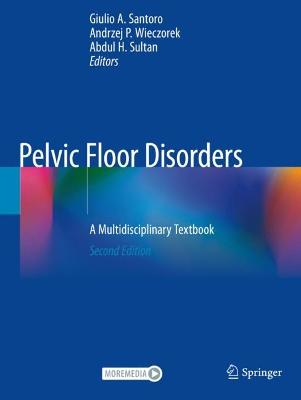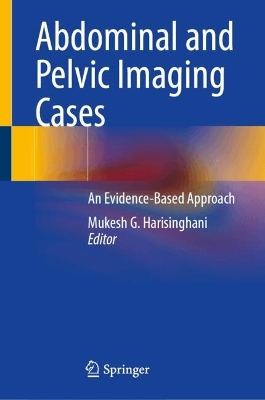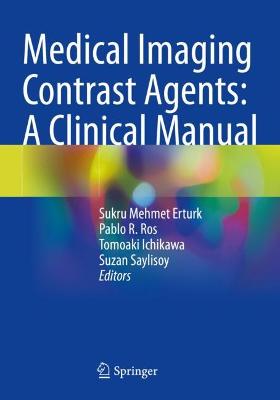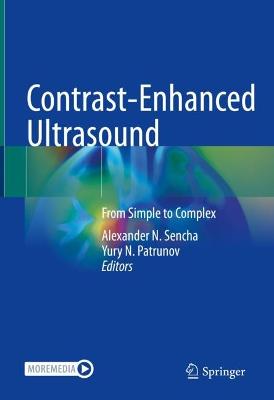Pelvic Floor Disorders
 portes grátis
portes grátis
Pelvic Floor Disorders
A Multidisciplinary Textbook
Wieczorek, Andrzej P.; Sultan, Abdul H.; Santoro, Giulio A.
Springer Nature Switzerland AG
12/2021
1203
Mole
Inglês
9783030408640
15 a 20 dias
3517
Descrição não disponível.
Section I - Pelvic Floor Anatomy and Physiology: 1. State of the Art Pelvic Floor Anatomy - 2. Biochemical Properties and Hormonal Receptors of Pelvic Floor Tissues.- 3. The Integral Theory: A Musculo-elastic Theory of Pelvic Floor Function and Dysfunction.- 4. The Pelvic Floor: Functional Concepts and Neurocontrol.- Section II - Pelvic Floor Imaging: 5. Principles and Technical Aspects of Integrated Pelvic Floor Ultrasound.- 6. Transperineal Ultrasonography: Methodology and Normal Pelvic Floor Anatomy.- 7. Endovaginal Ultrasonography: Methodology and Normal Pelvic Floor Anatomy.- 8. Endoanal and Endorectal Ultrasonography: Methodology and Normal Pelvic Floor Anatomy.-9. Technical Innovations in Pelvic Floor Ultrasonography - 10. X-ray Techniques: Methodology and Normal Pelvic Floor Anatomy.- 11. Magnetic Resonance Imaging: Methodology and Normal Pelvic Floor Anatomy.- 12. Dynamic Magnetic Resonance of the Pelvic Floor: Technique and Methodology. Section III -Obstetric PelvicFloor and Anal Sphincter Trauma: 13. Mechanisms of Pelvic Floor Trauma During Vaginal Delivery.- 14. Obstetric Perineal and Anal Sphincter Trauma.-15. Neurogenic Trauma During Vaginal Delivery.- 16. Prevention of Perineal Trauma. Section IV -Urinary Incontinence and Voiding Dysfunction: 17. Overview: Epidemiology and Etiology of Urinary Incontinence and Voiding Dysfunction. Assessment: 18. Patient-Reported Outcome Assessment.- 19. Urodynamics Techniques and Clinical Application.- 20. Ultrasonographic Techniques and Clinical Application. Management: 21. Behavioural Therapies and Biofeedback.- 22. Selection of Midurethral Slings for Women with Stress Urinary Incontinence.- 23. Tape Positioning- Does it matter?.- 24. Colposuspension and Fascial Slings.- 25. Injectable Biomaterials.- 26. Artificial Urinary Sphincter in Women.- 27. Pharmacological Treatment of Urinary Incontinence, Overactive Bladder and Voiding Dysfunction.- 28. Intravesical Botulinum toxin for treatment of Overactive Bladder 29. Sacral Nerve Stimulation for overactive bladder and voiding dysfunction. Section V - Anal Incontinence: 30. Overview: Epidemiology and Etiology of Anal Incontinence.- Assessment: 31. Patient-Reported Outcome Assessment.- 32. Anorectal Manometry: Techniques and Clinical Application.- 33. Three-dimensional Endoanal Ultrasonography.- 34. Transperineal Ultrasonography.- 35. Magnetic Resonance Imaging.- 36. Neurophysiological Evaluation: Techniques and Clinical Application. Management: 37. Treatment: Which Outcome Should We Measure?.- 38. Behavioural therapies and biofeedback.- 39. Pharmacological Treatment of Anal Incontinence: the Evidence.- 40. Sphincter Repair and Postanal Repair.- 41. Dynamic Graciloplasty.- 42. Injectable Biomaterials .- 43. Artificial Bowel Sphincter and Magnetic Anal Sphincter.- 44. Sacral Nerve Stimulation.- 45. Posterior Tibial Nerve Stimulation.- 46. Radiofrequency.- 47. Other Surgical Options for Anal Incontinence: From End Stoma to Stem Cell. Section VI - Pelvic Organ Prolapse: 48. Overview: Epidemiology and Etiology of Pelvic Organ Prolapse - Assessment: 49. Patient-Reported Outcome and Clinical Assessment .- 50. Integrated Imaging Approach to Pelvic Organ Prolapse.- 51. Transperineal Ultrasonography for Pelvic Organ Prolapse and Levator ani Damage.- 52. Three-dimensional and Dynamic Endovaginal Ultrasonography for Pelvic Organ Prolapse and Levator ani Damage.-53. Magnetic Resonance and Levator Ani Damage.- 54. Dynamic Magnetic Resonance Imaging for Pelvic Organ Prolapse. Management: 55. Pelvic Floor Muscle Training in Prevention and Treatment of Pelvic Organ Prolapse.- 56. Use of Pessaries for Pelvic Organ Prolapse.- 57. Anterior and posterior colporrhaphy - native tissue versus mesh.- 58. The Abdominal versus Vaginal approach to middle compartment prolapse.- 59. The Laparoscopic Approach to Urogenital Prolapse - 60. The Robotic Approach to Urogenital Prolapse.- 61. Concurrent continence and prolapse surgery - 62. Multidisciplinary Approach for pelvic organ prolapse - the way forward?.-Section VII - Constipation and Obstructed Defecation: 63. Epidemiology, Phatophysiology, Evaluation and Management of Constipation and Obstructed Defecation. An Overview. Assessment: 64. Patient-Reported Outcome and Clinical Assessment.- 65. Anorectal Manometry, Rectal Sensory Testing and Evacuation Tests.-66. Transperineal Ultrasonography and Obstructed Defecation.-67. Echodefecography: Technique and Clinical Application.- 68 Evacuation Proctography.- Management: 69. Pharmacological Treatment of Irritable Bowel Syndrome and Constipation: the Evidence .- 70. The Abdominal Approach to Rectal Prolapse.- 71. The Perineal Approach to Rectal Prolapse.- 72. The Laparoscopic Approach to Posterior Compartment Prolapse.- 73. The Robotic Approach to Rectal Prolapse.-74. Sacral Nerve Stimulation in Constipation.- Section VIII - Pelvic Pain and Sexual Dysfunction.-75. Painful Bladder Syndrome.- 76. Pelvic Pain Associated with a Gynecologic Etiology.-77. Pelvic Pain Associated with a Coloproctologic Etiology.- 78 Female sexual dysfunction.- 79. Surface Electromyography and Myofascial Therapy.-80. Pharmacological Treatment of Chronic Pelvic Pain.-Section IX - Fistula: 81. Urogenital Fistulae.- 82. Rectovaginal Fistulae.- 83. Emerging Concepts in Classification of Anorectal Fistulae.- 84. Ultrasonographic Assessment of Anorectal Fistulae.- 85. MRI Assessment of Anorectal Fistulae.- 86. Surgical Treatment of Anorectal Fistulae.- 87. Management of Anorectal Fistulae in Crohn's Disease.- Section X - Failure or Recurrence after Surgical Treatment: What to Do When it All Goes Wrong: 88. Imaging of Complications After Urogynecologic Surgery.- 89. Surgical Management of Complications After Urogynecologic Surgery.- 90. Imaging of Complications After Colorectal Surgery.- 91. Surgical Management of Complications after Colorectal Surgery. Section XI - Miscellaneous: 92. Congenital Abnormalities of the Pelvic Floor: Assessment and Management.- 93. Male Urinary Incontinence:Assessment and Management. Appendix: A1. Algorithm Treatment for Urinary Incontinence; A2. Algorithm Treatment for Anal Incontinence; A3. Algorithm Treatment for Pelvic Organ Prolapse; A4. Algorithm Treatment for Constipation and Obstructed Defecation; A5. Algorithm Treatment for Chronic Pelvic Pain; A6. Algorithm Treatment for GenitoUrinary Fistulas, A6. Algorithm Treatment for Anorectal Fistulas.
Este título pertence ao(s) assunto(s) indicados(s). Para ver outros títulos clique no assunto desejado.
3D ultrasonography;Dynamic magnetic resonance;Dynamic ultrasonography;Pelvic floor anatomy;Pelvic floor ultrasonography;imaging;Anal Sphincter Trauma;Voiding Dysfunction;Urinary Incontinence;Anal Incontinence;Pelvic Organ Prolapse;Sexual Dysfunction;Pelvic Pain;Anorectal Fistulae
Section I - Pelvic Floor Anatomy and Physiology: 1. State of the Art Pelvic Floor Anatomy - 2. Biochemical Properties and Hormonal Receptors of Pelvic Floor Tissues.- 3. The Integral Theory: A Musculo-elastic Theory of Pelvic Floor Function and Dysfunction.- 4. The Pelvic Floor: Functional Concepts and Neurocontrol.- Section II - Pelvic Floor Imaging: 5. Principles and Technical Aspects of Integrated Pelvic Floor Ultrasound.- 6. Transperineal Ultrasonography: Methodology and Normal Pelvic Floor Anatomy.- 7. Endovaginal Ultrasonography: Methodology and Normal Pelvic Floor Anatomy.- 8. Endoanal and Endorectal Ultrasonography: Methodology and Normal Pelvic Floor Anatomy.-9. Technical Innovations in Pelvic Floor Ultrasonography - 10. X-ray Techniques: Methodology and Normal Pelvic Floor Anatomy.- 11. Magnetic Resonance Imaging: Methodology and Normal Pelvic Floor Anatomy.- 12. Dynamic Magnetic Resonance of the Pelvic Floor: Technique and Methodology. Section III -Obstetric PelvicFloor and Anal Sphincter Trauma: 13. Mechanisms of Pelvic Floor Trauma During Vaginal Delivery.- 14. Obstetric Perineal and Anal Sphincter Trauma.-15. Neurogenic Trauma During Vaginal Delivery.- 16. Prevention of Perineal Trauma. Section IV -Urinary Incontinence and Voiding Dysfunction: 17. Overview: Epidemiology and Etiology of Urinary Incontinence and Voiding Dysfunction. Assessment: 18. Patient-Reported Outcome Assessment.- 19. Urodynamics Techniques and Clinical Application.- 20. Ultrasonographic Techniques and Clinical Application. Management: 21. Behavioural Therapies and Biofeedback.- 22. Selection of Midurethral Slings for Women with Stress Urinary Incontinence.- 23. Tape Positioning- Does it matter?.- 24. Colposuspension and Fascial Slings.- 25. Injectable Biomaterials.- 26. Artificial Urinary Sphincter in Women.- 27. Pharmacological Treatment of Urinary Incontinence, Overactive Bladder and Voiding Dysfunction.- 28. Intravesical Botulinum toxin for treatment of Overactive Bladder 29. Sacral Nerve Stimulation for overactive bladder and voiding dysfunction. Section V - Anal Incontinence: 30. Overview: Epidemiology and Etiology of Anal Incontinence.- Assessment: 31. Patient-Reported Outcome Assessment.- 32. Anorectal Manometry: Techniques and Clinical Application.- 33. Three-dimensional Endoanal Ultrasonography.- 34. Transperineal Ultrasonography.- 35. Magnetic Resonance Imaging.- 36. Neurophysiological Evaluation: Techniques and Clinical Application. Management: 37. Treatment: Which Outcome Should We Measure?.- 38. Behavioural therapies and biofeedback.- 39. Pharmacological Treatment of Anal Incontinence: the Evidence.- 40. Sphincter Repair and Postanal Repair.- 41. Dynamic Graciloplasty.- 42. Injectable Biomaterials .- 43. Artificial Bowel Sphincter and Magnetic Anal Sphincter.- 44. Sacral Nerve Stimulation.- 45. Posterior Tibial Nerve Stimulation.- 46. Radiofrequency.- 47. Other Surgical Options for Anal Incontinence: From End Stoma to Stem Cell. Section VI - Pelvic Organ Prolapse: 48. Overview: Epidemiology and Etiology of Pelvic Organ Prolapse - Assessment: 49. Patient-Reported Outcome and Clinical Assessment .- 50. Integrated Imaging Approach to Pelvic Organ Prolapse.- 51. Transperineal Ultrasonography for Pelvic Organ Prolapse and Levator ani Damage.- 52. Three-dimensional and Dynamic Endovaginal Ultrasonography for Pelvic Organ Prolapse and Levator ani Damage.-53. Magnetic Resonance and Levator Ani Damage.- 54. Dynamic Magnetic Resonance Imaging for Pelvic Organ Prolapse. Management: 55. Pelvic Floor Muscle Training in Prevention and Treatment of Pelvic Organ Prolapse.- 56. Use of Pessaries for Pelvic Organ Prolapse.- 57. Anterior and posterior colporrhaphy - native tissue versus mesh.- 58. The Abdominal versus Vaginal approach to middle compartment prolapse.- 59. The Laparoscopic Approach to Urogenital Prolapse - 60. The Robotic Approach to Urogenital Prolapse.- 61. Concurrent continence and prolapse surgery - 62. Multidisciplinary Approach for pelvic organ prolapse - the way forward?.-Section VII - Constipation and Obstructed Defecation: 63. Epidemiology, Phatophysiology, Evaluation and Management of Constipation and Obstructed Defecation. An Overview. Assessment: 64. Patient-Reported Outcome and Clinical Assessment.- 65. Anorectal Manometry, Rectal Sensory Testing and Evacuation Tests.-66. Transperineal Ultrasonography and Obstructed Defecation.-67. Echodefecography: Technique and Clinical Application.- 68 Evacuation Proctography.- Management: 69. Pharmacological Treatment of Irritable Bowel Syndrome and Constipation: the Evidence .- 70. The Abdominal Approach to Rectal Prolapse.- 71. The Perineal Approach to Rectal Prolapse.- 72. The Laparoscopic Approach to Posterior Compartment Prolapse.- 73. The Robotic Approach to Rectal Prolapse.-74. Sacral Nerve Stimulation in Constipation.- Section VIII - Pelvic Pain and Sexual Dysfunction.-75. Painful Bladder Syndrome.- 76. Pelvic Pain Associated with a Gynecologic Etiology.-77. Pelvic Pain Associated with a Coloproctologic Etiology.- 78 Female sexual dysfunction.- 79. Surface Electromyography and Myofascial Therapy.-80. Pharmacological Treatment of Chronic Pelvic Pain.-Section IX - Fistula: 81. Urogenital Fistulae.- 82. Rectovaginal Fistulae.- 83. Emerging Concepts in Classification of Anorectal Fistulae.- 84. Ultrasonographic Assessment of Anorectal Fistulae.- 85. MRI Assessment of Anorectal Fistulae.- 86. Surgical Treatment of Anorectal Fistulae.- 87. Management of Anorectal Fistulae in Crohn's Disease.- Section X - Failure or Recurrence after Surgical Treatment: What to Do When it All Goes Wrong: 88. Imaging of Complications After Urogynecologic Surgery.- 89. Surgical Management of Complications After Urogynecologic Surgery.- 90. Imaging of Complications After Colorectal Surgery.- 91. Surgical Management of Complications after Colorectal Surgery. Section XI - Miscellaneous: 92. Congenital Abnormalities of the Pelvic Floor: Assessment and Management.- 93. Male Urinary Incontinence:Assessment and Management. Appendix: A1. Algorithm Treatment for Urinary Incontinence; A2. Algorithm Treatment for Anal Incontinence; A3. Algorithm Treatment for Pelvic Organ Prolapse; A4. Algorithm Treatment for Constipation and Obstructed Defecation; A5. Algorithm Treatment for Chronic Pelvic Pain; A6. Algorithm Treatment for GenitoUrinary Fistulas, A6. Algorithm Treatment for Anorectal Fistulas.
Este título pertence ao(s) assunto(s) indicados(s). Para ver outros títulos clique no assunto desejado.







